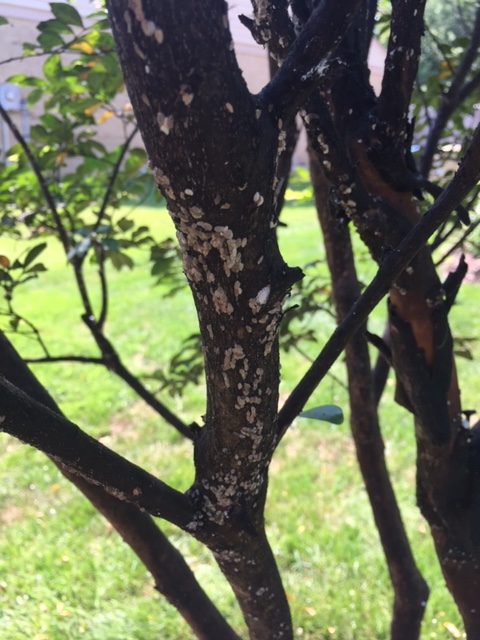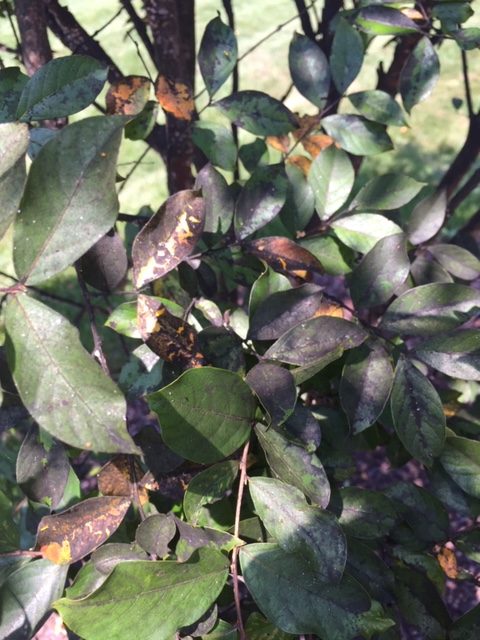Key Takeaways
- Identification is Key to Early Treatment
Crape myrtle bark scale presents distinct symptoms – from white spots on bark that turn black to sticky honeydew and sooty mold. Understanding these early warning signs allows for timely intervention before severe damage occurs. - Treatment Requires Systematic Approach
While various treatment methods exist, the most effective control comes from a comprehensive systemic treatment regimen that addresses current infestations, prevents future outbreaks, and supports overall tree health. - Prevention Through Proper Tree Care
Maintaining healthy trees through proper watering, appropriate fertilization, and regular inspections is the best defense against infestations. Well-maintained trees are more resistant to pest attacks and better equipped to recover if infected.

Call 703-573-3029
Request a Consultation Online
What is Crape Myrtle Bark Scale?
Crape myrtle bark scale is an insect that feeds on the sap of crape myrtle trees. It’s a small, flat, reddish-brown scale insect that attaches itself to the bark of the tree and sucks the sap out of it. The first signs of infestation are small, white spots on the bark that eventually turn black as the insects continue to feed. The damage caused by this pest can weaken the tree, leaving it vulnerable to disease and other pests.
Life Cycle
Like other scale species, this invasive pest goes through several life stages, including egg, crawler, and adult. The insects overwinter as adults and begin to lay eggs in the spring. The eggs hatch into crawlers, which move around the tree before settling down to feed. They eventually molt and become adults, starting the cycle all over again. Knowing the life cycle can help you time your treatments and prevent further infestations.
What are the Symptoms?
Many of our customers call us in the spring and summer because they see damage from the previous year’s infestation or evidence of a current infestation. Some of the symptoms you can look out for include black bark (caused by sooty mold), visible clusters of white insects on the bark, sticky honeydew dripping from the leaves, branch dieback, early leaf drop, and less vigorous blooms.

Will Crape Myrtle Bark Scale Kill the Tree?
This invasive pest can cause significant damage to the tree over time, including death, if the infestation is severe enough. A serious infestation can cause significant branch dieback. Additionally, an infestation can cause the tree to become more susceptible to other problems, which can affect the tree’s health and even cause death.
How to Get Rid of Crape Myrtle Bark Scale?
Researchers have been grappling with how to kill bark scale on crepe myrtles. Several methods are being tested, including manual removal, horticultural oils, and systemic insecticides. We have found that the best control comes from a systemic treatment regimen. Our regimen focuses on controlling the active pest population, preventing new infestations, and boosting the tree’s health. While we often recommend horticultural oils for natural control of other types of scale, this method alone is not as effective for crape myrtle bark scale control due to the invasive nature of this pest.
Can infestation be prevented?
Prevention is the best way to avoid having to deal with an infestation. Keep your trees healthy by making sure they’re getting enough water and nutrients and avoid over-fertilizing them. Regularly inspect your trees for signs of damage or pests and take action as soon as you notice a problem. A healthy, well-maintained tree is less likely to attract pests and to succumb to an attack.
Crape myrtle bark scale can be a major problem for homeowners and businesses, but with the right treatment and prevention strategies, you can keep your trees healthy and thriving. If you’re dealing with an infestation, contact us and we can help!
Call 703-573-3029
Request a Consultation Online


